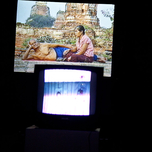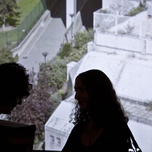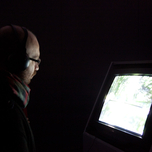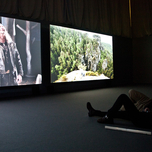VIDEO HOLES: I do not know what it is I am
Exhibition
29 November — 20 January 2012
Opening: 29 November, Thursday at 7 pm
Press Conference: 29 November at 11 am
Central Exhibition Hall «Manege» (Moscow, Manege Square, 1), ground floor
Organized by the Moscow City Government, the Department of Culture of Moscow, GBUK Moscow «Manege», Moscow museum of screen Culture MediaArtLab.
Support by The French Embassy and the French Institute, the Embassy of Finland, the Polish Cultural Centre, the British Council, Mondrian Foundation, Holiday Inn Lesnaya, National Cenre for Contemporary Arts (NCCA), Moscow Museum of Modern Art (MMOMA), the Buro Tolpin Peter Architects
Leading curator, author of the concept: Olga Shishko
Co-curator: Elena Rumyantseva
This November the MediaArtLab Centre for Art and Culture opens the Museum of screen culture at the Central Exhibition Hall Manege. This new space will become a unique platform for exhibitions, screenings, multimedia performances, a kind of interactive laboratory which will present major stages of media art history and also a bustling centre of creativity and education.
The Museum opens with the VIDEO HOLES: I do not know what it is I am exposition, an attempt to step across the borders of our perception of reality and carry the viewers away to other dimensions. Nine works by video artists in the language of video, an unprecedented channel for transmitting the states of mind, feelings and perceptions, trying to find nine routes, nine ways of man’s unending search and wanderings through space and time. An endless search for something that often is not the main purpose of the journey.
All authors in their own way find and show certain gaps in reality, logical discrepancies and distortions. Affirming the status of video as new poetry, Gary Hill presents it as «an effort to draw apart the surfaces that close again — but for a second a black gap appears as an expansion of a pupil or simply as an intake of breath — the images have to breathe, too».
On November 29th at the halls of the MediaArtLab Screen Culture Museum we have prepared a lot to see for the viewers — a European premiere of Jesper Just’s (Denmark/USA) multiscreen installation, a video by Provmyza duet (Russia), a noir mystification by Yang Fudong (China) and also a Russian premiere of Julian Rosefeldt’s (Germany) new work. These newest works enter into an equal dialogue with works by Gary Hill (USA), Bill Viola (USA), Marina Abramović (Serbia/USA) and Ulay (Germany), Tony Oursler (USA) and Thierry Kuntzel (France) who have already acquired a classical status.
The space of this exhibition will become a territory for interpenetration of images and meanings, for instance, Jean-Paul Sartre’s philosophical paradox «I am always not what I am; and I am always that which I am not» will be intertwined with the visual paradox of Bill Viola, I do not know what it is I am, the artist immersed in his search for something other that stays beyond the borders of contemporary progress. The artist has discovered for himself a space where the world of dreams spills into the real world and vice versa. Viola tries not only to surmount the limits of vision of reality, that is of what can be observed physically, but also to turn this act of vision itself into an intellectual experience.
Gary Hill is in search not only of philosophical meanings but of the holes in logic and visual gaps. He has said many times in his interviews that he wouldn’t work with video had he not felt that it engenders a new space, as yet unseen by the eye though felt by the body. Creating now an organized chaos, then quite the opposite — a disembodied order, the artist works with a space of paradox. His work Blind spot (2003) will presented at the exhibition.
Tony Oursler uses quite another approach — he fills the emerging void by creating universal self-contained worlds, using as material everything animate and inanimate. Moreover his own body acts as a lacking juncture between the eye and the camera. In his work The Loner (1980) the artist explores various body parts inspiring in them the fullness of life with the aid of color and movement.
The Provmyza group creates a feeling of dread in its work Eternity (2011) — they immerse the viewer into a multilayered space where the surrounding reality and a human gaze itself decompose and we find ourselves at a border in search of a dead point. A little girl serves as a metaphor of Eternity, as she mentally resists the destroying force and always defeats it.
The silent images and time in Thierry Kuntzel‘s La Desserte Blanche (1980) change inconspicuously, almost imperceptibly. What we see seems to be everlasting. As if the images have stopped in time and frozen.
Bill Viola in his work Chott-El-Djerid (A Portrait In Light And Heat) (1979) has surpassed not only the borders of reality’s perception, of what can be physically observed, he has also transformed the act of viewing into a mental experience. At Chott El-Djerid Viola discovered a space where the dream world seems to combine with the world of waking reality.
The video work by Marina Abramović and Ulay (Uwe Laysiepen) carries us away to the East describing the spiritual and ascetic aspects of the Eastern culture. The authors present a series of tableaus with monks and locals. The timeless harmony which is evident in City of Angels (1983) is created by the sense of a union between the genius loci, the soundtrack and participants.
Returning to the West, the viewers find themselves in German forests of the four-channel installation by Julian Rosefeldt My home is a dark and cloud-hung land (2011), who explores the connections between humans and their environment, the surrounding landscape and national mythology, metaphors and ideology. The author unveils links and correlations of natural and individual landscapes.
Jusper Just experiments with the theme of all-seing and not-seing in his work This Nameless Spectacle (2011). A story of detachment, impossibility of communication and alienation is played out on two gigantic panoramic screens that stand facing each other so that the viewer has to choose constantly between them and has no opportunity to see everything at once.
Yang Fudong in his work The Nightman Cometh (2011) creates a mythological illusory space which he tries to transform with video technology. The artist himself describes the genre of this film as neo-realist, an historic theatre where the main role is played by contemporary social conditions.
The VIDEO HOLES: I do not know what it is I am exposition will become a logical sequel to MediaArtLab’s ambitious research and the series of exhibition projects dealing with the exploration of crossing boundaries between cinema and contemporary art (Garage Centre for Contemporary Art, 2011; Moscow Museum of Modern Art, Yermolaevsky lane, 2011; Ekaterina Foundation, 2012).












